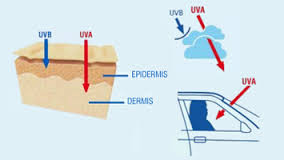|
SUN PROTECTION:
Vitamin D is a hormone and it is of interest to the skin care professional because it is only made in one place - the skin. We have found that when Vitamin D is balanced a lot of skin conditions like rosacea, eczema, psoriasis and heavy wrinkling will improve. However there are several products that wreak havoc on skin when exposed to sun. For instance, taking ibuprofen before sun exposure and cause a higher sensitivity to sunburn. Other photosensitizing ingredients are retinyl palmitate (and any vitamin A derivative including retinol, which should only be used at night), salicylic and glycolic acids, Hydroquinone, citrus essential oils and citrus based preservative. Hydroquinone: Hydroquinone has also been linked to photosensitivity. It has been reported that after four to five months of regular use, many clients begin to see a blueish color stain in the areas where it was used. Leading experts in hydroquinone have proposed that clients use it for no more than five months at a time. The skin must be given a break to allow it to stablize. A good sunscreen with zinc/titanium dioxide, avobenzone, or ecamsule blend should provide a good base plus a good antioxidant stable vitamin C under the sunscreen will help avoid and protect the skin from cancer. NECK & DECOLLETE
To the naked eye, the skin on the neck and decollete does not appear much different from that of the face, but it is quite different. Facial skin has a higher number of sebaceous glands that provide natural lubrication and protection. With fewer sebaceous glands on the neck and chest, there are reduced moisture levels, as well as a tendency toward dryness and dehydration. The skin on the neck and chest is thinner with less adipose tissue-the fat layer that supports the dermis-and more vascularity or blood vessels. The combination of thinner skin, increased vascularity, and loss of calcium and dehydration can greatly impact the appearance of the neck and decollete, resulting in an increase of lines and wrinkles, a red and blotchy appearance, and increased hyperpigmentation. There is a all-too-common mistake of not applying the same protection to the neck and chest as we do to our face. The 'necklace' wrinkles-wrinkles that appear as horizontal lines across the neck and occur due to sun exposure, ECM (extracellular matrix) breakdown, gravity and loss of elasticity. EMC is important cutaneous support structure that works to keep the skin full, taut and youthful. When exposed to UV radiation the EMC structural components becomre disorganized and cross-linked, disrupting the structure's ability to keep the skin firm, resulting in the formation of fine lines and wrinkles. UV radiation also contributes to an increase in melanocytic activity and abnormal dilation of the blood vessels, leading to uneven pigment, increased erythema (redness) and telangiectasias (spider veins) Poikiloderma of Civatte (PC)-is another condition found only on the neck and chest. It develops predominantly in women and tends to be more prevalent in fair-skinned individuals.This condition is a complex combination of hyperpigmentation and dilation of blood vessels, leaving a mottled appearance to the skin. PC is thought to be caused by accumulated UV exposure, increasing photo-sensitizing by the use of ingredients in cosmetics and perfumes,although hormones may also play a part in this condition. The development of deep vertical lines on the chest occur throughout time and are common in clients who prefer to sleep on their sides, compressing the skin between the breasts. This condition can be treated with topical to strengthen collagen, yet it cannot be kept from worsening without the client altering her sleep position. SOLUTIONS AND INGREDIENTS
It's never too late for clients to begin caring for their skin. Science in skin care has advanced and there are now ingredients available that have shown excellent results. An ingredient containing calcium hydroxymethionine and 3-aminopropane sulfonic acid has been tested for its efficacy on the tissues of the neck. Ingredients, such as palmitoyl tripepide-38, ( ingredient in cutting edge skin care products because it penetrates deep in to the dermis to boost the production of collagen. It stimulates the synthesis of hyaluronic acid, which is one of the chemicals responsible for new cell development. By assisting the body's natural regeneration process, helps skin to retain its youthful firmness and radiant glow Palmitoyl tripeptide-5 encourages skin strengthening by supporting the production of collagen, Retinol provides benefits for the skin, such as collagen and elastin stimulation, and a suppression of MMP enzymes. It is an antioxidant and it speed up cell turnover, a process that slows with age, leading to a dull complexion. Niacinamide reduces hyperpigmentation and redness. This B vitamin plays a role in multiple biochemical reactions within the skin. It is critical to ensure that clients follow a regimen using a broad-spectrum sun protection SPF 30 along with a good Vitamin C each day. |
The Myths and Realities of Acne
All acne is hormonally -induced - and once it takes place in a young person's skin, stress factors create more pressure on the hormonal cascade fluxes. Physiology studies show that starting somewhere before adolescence, perhaps ages nine or 10, the adrenal glands produce dihyrepiadrosterone sulfate (DHEAS). At puberty, other androgen, such as testosterone and hehydrotestonsterine (DHT), are produced. All these androgens suddenly stimulate the sebaceous gland to secrete more and more sebum. Attempting to dry this excess sebum out only exacerbate the glands to pump more sebum. Nutrition:Consuming a lot of breads, cakes, pastas, and other wheat products can also contribute to acne. Gluten causes damage to the small intestine, which could lead to nutritional deficiencies and an increased toxic body load (through leaky gut syndrome). People with gluten sensitivity cannot digest gluten effectively. As a result, they absorb partially-digested protein molecules. The immune system treats these molecules as invaders and as it attacks these invaders, the white blood cells release histamine, which increases inflammation. Inflammation increases insulin resistance in the nearby cell structures. Insulin resistance leads to blood sugar problems,. Stress is another enemy. When a person is stressed out, their body releases cortisol. The sebaceous gland sacs have receptors for this hormone that increase sebum production. High levels of cortisol can inhibit collagen production. Home Use recommendations: Bar soap is not recommended to cleanse skin because alkaline salts, used to solidify oils and surfactants in a bar of soap, also solidity the sebum oil in the skin, leading to congestion. Liquid soaps with strong ingredients strip oil from the skin and increase excessive sebum flow. The sebaceous oil gland pumps even more oil to replace sebum that has been stripped away. Benzyl peroxide cleansers are adequate for short-term use, but tend to dry out skin. In addition, long use of benzyl peroxide becomes a free radical in tissue. A good acne cleanser should be sulfate and parabens free with a small amount of salicylic acid. Panthenol (vitamin B) controls bacterial growth and also re-balances sebum production through the increase of co enzyme A which is involved in the breaking down of excess sebum. Here's a good remedy instead of squeezing and spreading bacteria. Make a salve that contains powerful ingredients: cassia, clove and capsicum cayenne pepper. Cassia and clove create pseudo heat when applied to a swollen pustule. This immediately stimulate the capillaries: thus, the skin heats up. The hardened sebum then starts to liquefy and the increased blood circulation carries off the toxins. Capsicum is also high in enzymes which releases hormones into the blood stream. Cayenne also has antibacterial properties and is rich in vitamin A. Simple cleanse skin, pat dry, and apply small dot of the salve to pustules daily. Supplement zinc tablets (at least 50 milligrams) and sea buckthorn oil with evening primrose oil; eliminate or reduce sugar, dairy and gluten drastically from diet; and increase alkalinity in diet with more vegetable, lean meats, less sodas, and processed foods. Professional skin treatment (oxygen therapy) for at least 3 mo Innovative Eye Treatments—Powerful Peptides and Beneficial Botanicals
The eyes are one of the most important facial features in contributing to each person’s unique appearance, personality and how one communicates with the outside world. Unfortunately, the eye area is also one of the first places on the face to show the visible signs of aging.
For clients looking to reduce the visible signs of aging around the eyes, there is hope. Many of these new ingredients provide rapid, visible results if used regularly along with the measure of UV protection. Long-term benefits take time, however, nothing is wrong with wanting immediate results as well. Boron nitride is a naturally occurring mineral that can leave dark circles and undereye bags immediately brighter upon application by reflecting light away from the eye area. This is a nice addition to an eye product if immediate brightening is wanted. By utilizing these useful ingredients, you not only help slow the development of these signs of aging, but also improve the appearance of existing fine lines, wrinkles, undereye puffiness and eyelid laxity. Palmitoyl tripeptide-38. The newest generation of matrix-building peptides, this ingredient can be used successfully to treat all skin, but it is especially effective in treating the eye area, as the loss of collagen and other matrix components is highly apparent there. This amino acid chain has demonstrated the ability to increase the production of six highly important dermal and epidermal components, as well as one important protein. Myristoyl pentapeptide-8 and myristoyl hexapeptide-4. Excellent choices for the eye area, these two peptides stimulate collagen synthesis and tissue repair without inflammation, and provide an effective alternative to human growth factor. Myristoyl nonapeptide-3. An exciting alternative to retinol, which has proven skin benefits, but can often be too irritating for some patients, this new peptide mimics the action of retinoic acid--vitamin A—without causing negative side effects, such as stinging. This retinopeptide has demonstrated the ability to increase collagen production and increase the processes associated with improving retinoic acid activity in the skin, as well as regulating connective tissue growth factors that lead to more youthful fibroblast activity. Acetyl tetrapeptide-5. A peptide that inhibits the glycation that ultimately leads to collagen cross-linking and ECM breakdown, its anti-edema effects increase skin elasticity and moisturization, while reducing undereye puffiness and improving the appearance of dark circles around the eyes. Dipeptide diaminobutyroyl benzylamide diacetate. A next-generation peptide that has a fast-acting wrinkle-smoothing effect around the eyes, diminishing wrinkles and expression lines, it functions by attenuating the muscle contractions around the eyes that are responsible for creating the aged look of this important facial area. |


